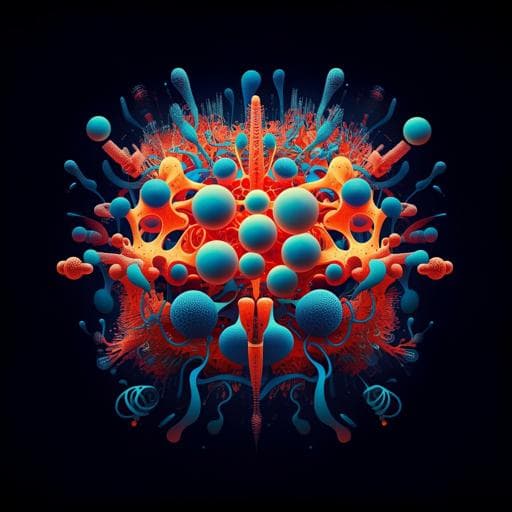
Biology
A versatile and customizable low-cost 3D-printed open standard for microscopic imaging
B. Diederich, R. Lachmann, et al.
Explore the innovative UC2—a low-cost, 3D-printed, open-source modular microscopy toolbox developed by a team of researchers, including Benedict Diederich and René Lachmann. This versatile suite includes designs for monitoring cell differentiation and performing volumetric observations, pushing the boundaries of optical science.
~3 min • Beginner • English
Introduction
The paper addresses the need for accessible, adaptable, and affordable microscopy platforms that can meet growing demands in spatiotemporal resolution, imaging volume, specificity, and long-term live imaging. Commercial systems are often costly, difficult to modify, and poorly documented, hindering reproducibility and education. The authors propose an open, modular standard for optical microscope construction (UC2) based on 4f optical design principles and standardized mechanical modules to enable rapid reconfiguration across modalities. Their goal is to reduce barriers between microscope engineers and users, improve reproducibility through open documentation, and provide a versatile platform for research and education.
Literature Review
The authors review recent advances in open-source and low-cost microscopy and related toolkits: service-oriented access to light-sheet microscopy (Flamingo), open-access platforms like lattice light-sheet and openSPIM that promote education, open-flexure stages, the €100 lab, Foldscope, and open-source SMLM systems. They also cite generic optomechanical toolboxes (e.g., 3D printable cage systems, μCube) and enabling technologies such as 3D printing, Arduino, Raspberry Pi, and smartphone cameras. Computational methods (autofocus, deconvolution, quantitative phase via LED arrays) can compensate for limitations from inexpensive optics and mechanics. These efforts motivate the need for a unifying open standard that expands interoperability and reusability across components and systems.
Methodology
Design and hardware: UC2 uses a modular cube-based framework adhering to 4f optical principles with a 50 mm design pitch for component compatibility. Cubes are 3D printed (primarily PLA; ABS for higher-temperature stability parts like Z-stage and horizontally mounted baseplates). A magnetic snap-fit mechanism uses 5 mm neodymium ball magnets in baseplates and M3 cylindrical screws in cube edges for rapid, stable assembly, with optional power delivery via magnets and rectifiers to avoid polarity issues. The cubes include inserts to host lenses, mirrors, cameras, motors, LEDs, and can interface with commercial rail/cage systems. A module developer kit provides reference designs for customization.
Incubator-enclosed bright-field system: A low-cost finite-conjugate objective (10x, NA 0.3) forms an image at reduced tube length (~100 mm), folded by a cosmetic mirror, captured by a Raspberry Pi v2.1 camera on a Raspberry Pi 3B. A monolithically printed Z-stage with linear or flexure bearings and worm drive (M3 screw, 28BYJ-48 stepper) provides focus. Optional low-cost XY micro-stages enable sample positioning. Illumination uses an 8x8 LED array with a GUI enabling individual LED control for contrast optimization; fluorescence modules use high-power LEDs (450 nm/405 nm) and a gel filter (ROSCO #11). A GUI on a 7-inch touchscreen manages modalities, scheduling, and synchronization.
Electronics and control: Active modules connect via Arduino Nano over a wired bus or ESP32 using MQTT for wireless control; a Raspberry Pi 3B acts as master on wired connections. Communication supports I2C and MQTT. Power can be delivered through conductive magnets/wires.
Software and acquisition: A Python-based GUI controls experiments, hardware/frame sync, and illumination patterns. Raspberry Pi camera frames are saved as JPEG (with RAW Bayer data in EXIF when needed). For smartphone imaging (Huawei P9/P20 Pro), the FreeDCam app provides RAW access and manual controls. USB power banks enable field operation. Autofocus employs spatial (Tennegrad) and variance-based sharpness metrics.
Image processing: Long-term datasets are managed via Python scripts that bin RAW data, generate previews, and compute per-frame statistics (min, max, mean, sharpness) and drift via cross-correlation using fixed ROIs (e.g., sensor dirt). ABS thermal drift during incubator heat-up is mitigated by excluding corrupted frames, applying XY shift corrections, and averaging. Green channel processing includes flat-fielding and dirt correction by dividing by the mean stack after background correction. Fiji (v1.53c) is used for cell size and roundness measurements. Cloud-based ImJoy workflows are used for on-device processing (e.g., ISM). For aIDT phase reconstructions, Matlab code from Li et al. with minor modifications is used. Light-sheet Z-stacks are registered (cross-correlation) and deconvolved using the GenericDeconvolution program (available upon request).
Sample preparation: PBMCs were isolated via Ficoll density centrifugation with ethics approval (University Hospital Jena 2018-1052-BO). Monocytes were seeded and differentiated under specified media conditions (X-Vivo 15 with supplements, GM-CSF, M-CSF) and prepared over several steps (washing, lidocaine/EDTA incubation, centrifugation) before imaging in 35 mm dishes. Additional protocols are detailed in Supplementary Notes.
Statistics and reproducibility: Representative images reflect a minimum of three biological and non-biological replicates. For macrophage growth analysis, one-way ANOVA with Tukey’s correction was used (n=4 independent experiments).
Key Findings
- UC2 toolbox: A low-cost, 3D-printed, modular open-standard enabling rapid construction and reconfiguration of microscopes using 4f principles and magnetic cube modules (50 mm pitch), interoperable with common optomechanical systems.
- Incubator-enclosed bright-field microscope: Self-contained system successfully monitored monocyte-to-macrophage differentiation in vitro continuously for 7 days (168 h) at cellular resolution (~2 µm), with stable focus supported by autofocus/manual refocus and robust mechanics.
- Parallelization: Four identical systems operated in parallel for week-long imaging, demonstrating high throughput on a low budget and suitability for constrained environments (e.g., microfluidics, BSL3+).
- Light sheet fluorescence microscope: By swapping few components (laser pointer, additional objective, beam expander, cylindrical lens, larger baseplate), the BF system converted into a ~400 Euro light-sheet microscope. Acquired 3D Z-stacks of GFP-expressing zebrafish vasculature; data were drift-corrected and deconvolved. Presented as proof-of-concept suitable for education.
- Fluorescence performance and benchmarking: For mCLING-ATTO 647N-labeled E. coli using a UC2 infinity-corrected fluorescence microscope, practical resolution by FRC was d_cellphone ≈ 0.6 µm vs d_Raspi ≈ 1.13 µm and d_zeiss ≈ 0.27 µm (Zeiss Axiovert TV), at similar conditions. Cellphone (monochrome, back-illuminated) notably improved sensitivity over Raspberry Pi camera.
- Image Scanning Microscopy (ISM) and structured illumination: Using a laser-scanning projector module, UC2-ISM produced “superconfocal” images with improved optical sectioning vs wide-field; comparable qualitative results to a commercial confocal (Leica TCS SP5).
- Label-free quantitative methods: With LED matrices/rings and computational reconstruction, UC2 demonstrated bright-field, dark-field, quantitative phase imaging (qDPC, FPM) and annular Intensity Diffraction Tomography (aIDT) with computational refocusing.
- Quantitative cell analysis: Macrophage morphology changes over time observed; statistical testing (one-way ANOVA with Tukey correction) indicated significance in cell area changes (p = 0.034; F = 10.76; DF = 11; n = 4 independent experiments).
- Educational impact: “TheBOX” and “CourseBOX” collections, with minimal printed/off-the-shelf parts and documentation, enabled building diverse optical instruments (microscopes, telescopes, projectors, diffraction setups, holography) and reduced learning barriers across workshops and courses.
Discussion
UC2 establishes a practical open standard for modular optics by defining a common mechanical interface (cube dimensions, magnetic coupling) and leveraging 4f optical design to simplify system layout and interoperability with existing rails and cage systems. This design enables rapid prototyping, straightforward modality switching, and adaptability to diverse imaging tasks in research and education. The incubator-enclosed bright-field system demonstrated robust long-term performance, enabling week-long, parallelized live-cell experiments that corroborate literature findings (e.g., links between macrophage elongation and motility). Extensions to light-sheet, fluorescence, ISM, and computational phase imaging underline the platform’s multimodal versatility.
The work highlights that computational methods and consumer electronics can mitigate limitations of low-cost optics/mechanics, broadening access to advanced microscopy techniques. However, certain components (e.g., Raspberry Pi v2.1 camera) limit fluorescence sensitivity and resolution, positioning the low-cost light-sheet primarily as an educational demonstrator rather than a production instrument. Overall, UC2 promotes reproducibility and transparency by providing open designs, BOMs, and software, potentially becoming for optics what Arduino is for electronics and Fiji for image processing.
Conclusion
The paper presents UC2, a versatile, customizable, and affordable 3D-printed modular microscope framework that defines an open standard for optical system construction. It demonstrates a complete development cycle from concept to application with an incubator-enclosed bright-field microscope enabling week-long live-cell imaging, and showcases rapid reconfiguration into additional modalities including a low-cost light-sheet system, fluorescence microscopy, ISM, and quantitative phase imaging. UC2’s open hardware/software ecosystem, documentation, and educational kits lower barriers to building and understanding advanced microscopy, fostering reproducibility and rapid prototyping.
Future directions include improving mechanical stability with advanced materials or designs, integrating more sensitive camera sensors (e.g., industrial or smartphone-grade monochrome sensors) for better fluorescence performance, refining optical components for the light-sheet configuration, and expanding interoperable modules and software integrations with platforms like Micro-Manager, OpenFlexure, and ImJoy.
Limitations
- Mechanical stability: PLA/ABS components can deform with temperature (e.g., 37 °C incubator conditions), potentially inducing drift; mitigated via autofocus and design iterations but remains a constraint for long-term precision.
- Fluorescence sensitivity: Raspberry Pi v2.1 camera exhibits high noise and reduced sensitivity (Bayer pattern), limiting fluorescence and light-sheet performance; more sensitive cameras substantially improve results.
- Light-sheet performance: The ~400 Euro light-sheet setup is a proof-of-concept primarily suited for educational purposes; better optics and application-specific adaptations are required for higher performance.
- General precision: Low-cost optics and mechanics may introduce aberrations and reduced stability, partly compensated by computational methods but still below high-end research systems in performance.
Related Publications
Explore these studies to deepen your understanding of the subject.







